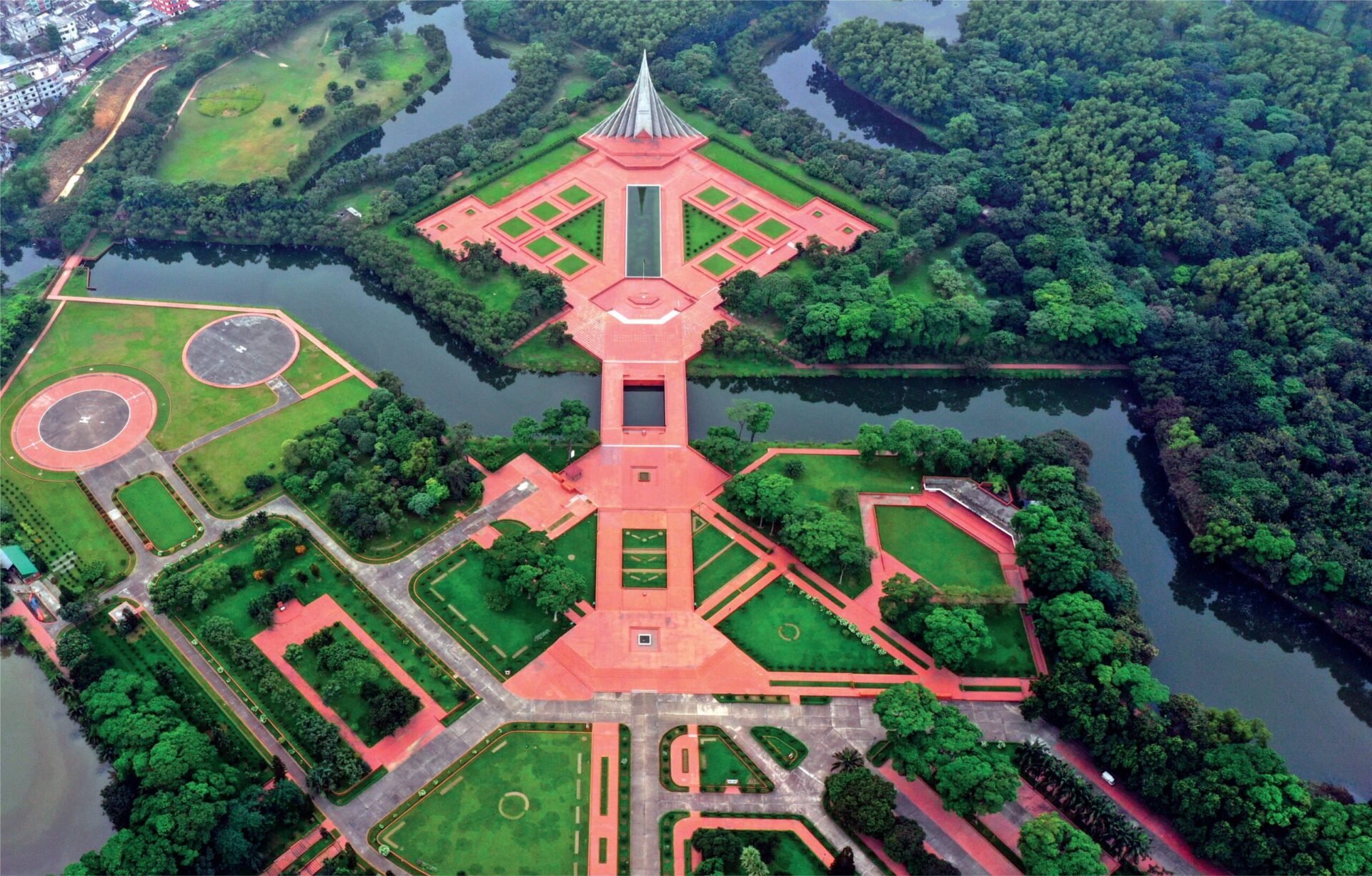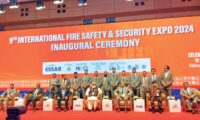
An Ode to Resilience: Shaheed Minar’s Chronicle of Revival
In the Bengali calendar, the month of Falgun signifies new journey of life and a sense of rejuvenation. The month which marks beginning of the spring brings forth joy, vivid hues, and a feeling of renewal. During this time, Bangladesh comes to life with the mesmerizing songs of cuckoos and various f lowers that are in bloom. Urban streets and rural roads are painted with colours of fallen leaves and shades of flowers. However, on the eighth day of Falgun, February 21, 1952, the Dhaka city’s streets were transformed into haunting canvases as the vibrant hues of nature gave way to a chilling shade of dark red. In defiance of the curfew imposed, courageous students took to the streets, passionately demanding that Bangla and only Bangla be recognised as the nation’s state language. The police opened fire on the students. Salam, Barkat, Rafiq, Jabbar, and a few others tragically lost their lives in the incident. Many people were injured. The news of the shooting spread like wildfire in every corner of the city. Soon after, the office court, secretariat, and wireless centre employees decided to collectively refrain from attending work. A wave of frustration swept through the city, drawing people towards the Dhaka medical hostel premises. After a day of fervent protests and demonstrations, the leaders of the student community agreed as a group to honour the language martyrs by constructing a monument. The information quickly got to Badrul Alam, a 24-year-old artist who is well-known for his artistic talents. He knew they needed his creative touch in designing the monument. As soon as the design was approved, something extraordinary happened. The whole night, a dedicated team of people, including medical students, hostel staff, and volunteers, worked on building a Shahid Smriti Stambha. The funding for the monument came from Pearu Sardar, who was a well-known and respected Dhaka panchayet sardar. The symbolic structure, dedicated to honouring the language martyrs, was unveiled to the public on the morning of February 24, a testament to an exceptional display of unity and support. In poignant recognition of his pivotal role in the language movement, Dr. Badrul Alam received the Ekushey Padak in 2014; he was the designer of the First Shahid Minar (Martyrs’ Monument) in 1952. This narrative unfolds as a tale of community solidarity, with the tireless efforts of diverse individuals coming together to construct an 11-foot-tall monument that stands as a lasting tribute to the language martyrs. However, the Pakistani Army and the police demolished it on February 26, 1952. In 1956, the students once again constructed the Shaheed Minar. It was inaugurated by Maulana Bhasani. But it was also disassembled afterward. Novera and Hamid’s grand design In the autumn of 1956, a pivotal meeting unfolded between Zainul Abedin, a luminary in the artistic realm, and Mr. Jabbar, the Chief Engineer of C&B, convened with the esteemed artist Hamidur Rahman and sculptor Novera Ahmed. The duo’s grand design took shape — a sprawling Shaheed Minar complex teeming with symbolism and significance. At its heart stood a semi-circular column, a poignant tribute to the eternal bond between mother and child, forever united in sacrifice. Adorning this column were symbols of watchful eyes, crafted from yellow and dark blue glass, poised to catch the sunlight and cast an ethereal glow upon the square below. The vision extended beyond mere architecture; it wove together threads of history and emotion, with every detail meticulously planned. A railing, adorned with Bangla alphabets, traced the perimetre of the seminar, while painted footprints, some stained with blood, others dark as night, marked the path of opposing forces, forever etched into the stone as a testament to the struggle for freedom. The Selection Committee, presided over by the venerable Greek architect Doxiadis, along with luminaries like Zainul Abedin and Mr. Jabbar, lent their discerning eyes to the fray. As Novera and Hamid poured their hearts into the design, they envisioned a space where memory and meaning intertwined — a sanctuary for reflection and remembrance. The government appointed Jean Delora as an architect at that time, who was in charge of keeping an eye on this work. Yet fate had other plans, and the grandeur of their vision remained but a dream, halted by the tumult of political upheaval and Ayub Khan’s martial law. Barkat’s mother inaugurated in 1963 In 1962, a committee under the direction of the vice-chancellor of Dhaka University suggested altering the original plan and speeding up the construction of the minaret. At that time, they did not even consider informing the designers about the alterations. Shaheed Barkat’s mother inaugurated it on February 21, 1963. In 1971, during the Operation Searchlight, Pakistani invaders descended upon the Shaheed Minar. They ravaged the monument. After independence, the government of Bangladesh took charge of the restoration of the Shaheed Minar. A fresh competition was announced, summoning the nation’s most esteemed artists and architects to present their visions for the revered monument. In a scene of anticipation and hope, the Central Hall of the Government House became a canvas for creativity as presentations adorned its walls. The committee, the media, and the general public all shared a mutual admiration for the design that Novera Ahmed and Hamidur Rahman’s team submitted. After that, its construction was f inished, though it failed to follow the design properly. In the mid-1980s, the Shaheed Minar underwent significant renovation again. The new design for the Shaheed Minar featured four small and one large column symbolising the mother and her fallen children on a 1,500-square-foot basis with a red sun backdrop. However, it was hastily executed, with the columns ending up shorter than planned and the main column’s head being bent more than intended. The Shaheed Minar took its present form in 1983, with marble stones used for repairs. The current Shaheed Minar stands at 14 meters (48 feet) tall. Unparallel significance of UNESCO recognition Since 1952, Bangladesh has embraced February 21st as National Martyr’s Day. On November 17, 1999, UNESCO, recognising its unparalleled significance,

Business -Of Verdant Backdrop Red Brick Surface and A Memorial Of Pride.
Architecture, in its own language, has the power to narrate stories, forge distinctive perspectives, and evoke profound emotions. The National Martyrs’ Memorial in Savar is one of those powerful architectures that bear the history and bravery of the nation with its grandeur and glory. Located in Savar, an industrial hub on the outskirts of Dhaka, the monument stands tall as an emblem of reverence, embodying the nation’s profound gratitude to those brave souls who made the ultimate sacrifice in the pursuit of self-determination for the Bengali people. After taking a short tour around it, visitors can’t help but feel a sense of awe and pride as they contemplate the nation’s immense history and resilience. The vast landscape, the luscious greenery surrounding it, and the soaring height of the establishment will remind of its relative insignificance in the grand scheme of things. The month of March in Bangladesh is a time of remembrance and reflection. For millions of Bangladeshis, Independence Day is a day of extraordinary sentiments, containing both happiness and grief as the country earned its sovereignty 54 years ago at the cost of 3 million lives. Three phases of construction: The National Martyrs’ Memorial is designed by architect Syed Mainul Hossain (1952-2014). With a distinguished jury, including architect Muzharul Islam, a national design competition for the monument took place in 1978. (The previous attempt didn’t yield any satisfactory results.) Among 57 contenders, the young 26-year-old architect Mainul emerged victorious with his standout design. The inception of the project dates back to 1972, marking the acquisition of approximately 110 acres by the government. Of this expanse, 84 acres were dedicated to the construction of the main complex, while the remaining land was set aside for a verdant land-water greenbelt. The initial phase saw the creation of access roads, laying the foundation for subsequent development. In the second phase spanning from 1974 to 1982, significant infrastructural elements such as mass graves, helipads, parking facilities, and pavements were meticulously established. Finally, the third phase in 1982 witnessed the realisation of the main monument, along with the establishment of the greenbelt and a cafeteria, concluding the completion of this national monumental endeavour. The main monument was built by Concord in 1982 in only 89 days. In 1988, architect Syed Mainul Hossain received the Ekushey Padak, one of the highest civilian honours of the country, in recognition of his profound contribution to Bangladesh’s cultural heritage. A sneak peek into this architectural marvel: The central structure of the National Martyrs’ Memorial comprises seven pairs of triangular shapes, each representing pivotal events that propelled Bangladesh towards its independence. Starting with the outermost and shortest triangle, the structures progressively increase in height, leading up to the innermost peak. This architectural metaphor symbolises the nation’s ascent despite formidable challenges. The monument is made of concrete, in contrast with the rest of the structures and pavements, which are made of red bricks. Its design offers a multifaceted viewing experience, presenting a symmetrical pyramid-like formation when observed from afar. However, closer inspection reveals a dynamic interplay of angles and perspectives, inviting visitors to explore its intricate details firsthand. Notably, the surface of the structure is intentionally uneven, mirroring the tumultuous journey towards freedom and independence. This tactile representation serves as a poignant reminder of the sacrifices made and the resilience required to overcome adversity. The whole campus is adorned with trees, walkways, an artificial lake, and a cafeteria. Interplay of numbers: Numerology serves as a hidden vital factor behind the intricate design of the National Monument, reminiscent of ancient architectural wonders like the Athenian Parthenon, where numbers were revered as the essence of aesthetic perfection and cosmic harmony. At the heart of this establishment lies the mystical number 7, symbolising the seven pivotal movements that shaped Bangladesh’s path to independence between 1952 and 1971. The first of these 7 historical contexts is the language movement of 1952. This was followed by the United Front elections of 1954, the Constitution Movement of 1956, the Education Movement of 1962, the Six-Point Movement of 1966, the People’s Uprising of 1969, and then the final victory through the Great Liberation War of 1971. However, these 7 pillars or the number 7 also have different implications if we look at them from different facets. For example, among others, the Language Movement in 1952 contains 5+2=7; December 16, the day of independence in 1971, has 1+6=7; and there were 7 Birsreshto (war heroes) who sacrificed their lives for the cause of liberation. Written Kaniz F. Supriya

Of Verdant Backdrop Red Brick Surface and A Memorial Of Pride
Architecture, in its own language, has the power to narrate stories, forge distinctive perspectives, and evoke profound emotions. The National Martyrs’ Memorial in Savar is one of those powerful architectures that bear the history and bravery of the nation with its grandeur and glory. Located in Savar, an industrial hub on the outskirts of Dhaka, the monument stands tall as an emblem of reverence, embodying the nation’s profound gratitude to those brave souls who made the ultimate sacrifice in the pursuit of self-determination for the Bengali people. After taking a short tour around it, visitors can’t help but feel a sense of awe and pride as they contemplate the nation’s immense history and resilience. The vast landscape, the luscious greenery surrounding it, and the soaring height of the establishment will remind of its relative insignificance in the grand scheme of things. The month of March in Bangladesh is a time of remembrance and reflection. For millions of Bangladeshis, Independence Day is a day of extraordinary sentiments, containing both happiness and grief as the country earned its sovereignty 54 years ago at the cost of 3 million lives. Three phases of construction: The National Martyrs’ Memorial is designed by architect Syed Mainul Hossain (1952-2014). With a distinguished jury, including architect Muzharul Islam, a national design competition for the monument took place in 1978. (The previous attempt didn’t yield any satisfactory results.) Among 57 contenders, the young 26-year-old architect Mainul emerged victorious with his standout design. The inception of the project dates back to 1972, marking the acquisition of approximately 110 acres by the government. Of this expanse, 84 acres were dedicated to the construction of the main complex, while the remaining land was set aside for a verdant land-water greenbelt. The initial phase saw the creation of access roads, laying the foundation for subsequent development. In the second phase spanning from 1974 to 1982, significant infrastructural elements such as mass graves, helipads, parking facilities, and pavements were meticulously established. Finally, the third phase in 1982 witnessed the realisation of the main monument, along with the establishment of the greenbelt and a cafeteria, concluding the completion of this national monumental endeavour. The main monument was built by Concord in 1982 in only 89 days. In 1988, architect Syed Mainul Hossain received the Ekushey Padak, one of the highest civilian honours of the country, in recognition of his profound contribution to Bangladesh’s cultural heritage. A sneak peek into this architectural marvel: The central structure of the National Martyrs’ Memorial comprises seven pairs of triangular shapes, each representing pivotal events that propelled Bangladesh towards its independence. Starting with the outermost and shortest triangle, the structures progressively increase in height, leading up to the innermost peak. This architectural metaphor symbolises the nation’s ascent despite formidable challenges. The monument is made of concrete, in contrast with the rest of the structures and pavements, which are made of red bricks. Its design offers a multifaceted viewing experience, presenting a symmetrical pyramid-like formation when observed from afar. However, closer inspection reveals a dynamic interplay of angles and perspectives, inviting visitors to explore its intricate details firsthand. Notably, the surface of the structure is intentionally uneven, mirroring the tumultuous journey towards freedom and independence. This tactile representation serves as a poignant reminder of the sacrifices made and the resilience required to overcome adversity. The whole campus is adorned with trees, walkways, an artificial lake, and a cafeteria. Interplay of numbers: Numerology serves as a hidden vital factor behind the intricate design of the National Monument, reminiscent of ancient architectural wonders like the Athenian Parthenon, where numbers were revered as the essence of aesthetic perfection and cosmic harmony. At the heart of this establishment lies the mystical number 7, symbolising the seven pivotal movements that shaped Bangladesh’s path to independence between 1952 and 1971. The first of these 7 historical contexts is the language movement of 1952. This was followed by the United Front elections of 1954, the Constitution Movement of 1956, the Education Movement of 1962, the Six-Point Movement of 1966, the People’s Uprising of 1969, and then the final victory through the Great Liberation War of 1971. However, these 7 pillars or the number 7 also have different implications if we look at them from different facets. For example, among others, the Language Movement in 1952 contains 5+2=7; December 16, the day of independence in 1971, has 1+6=7; and there were 7 Birsreshto (war heroes) who sacrificed their lives for the cause of liberation. Written Kaniz F. Supriya








